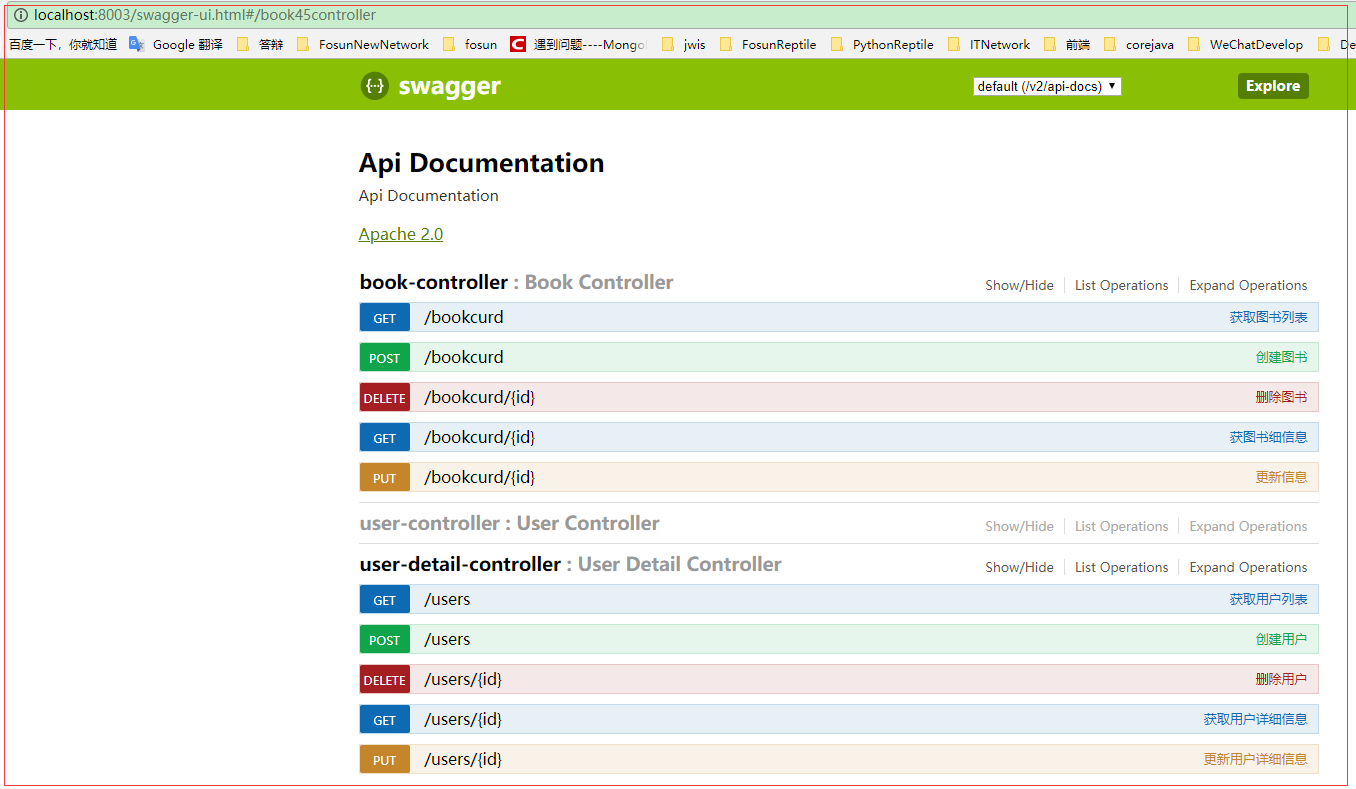前言
swagger,中文“拽”的意思。它是一个功能强大的api框架,它的集成非常简单,不仅提供了在线文档的查阅,
而且还提供了在线文档的测试。另外swagger很容易构建restful风格的api。
Swagger是一组围绕OpenAPI规范构建的开源工具,可帮助设计、构建、记录和使用REST API。
简单说下,它的出现就是为了方便进行测试后台的restful形式的接口,实现动态的更新,当我们在后台的接口
修改了后,swagger可以实现自动的更新,而不需要认为的维护这个接口进行测试。
swagger通过注解表明该接口会生成文档,包括接口名、请求方法、参数、返回信息的等等。
<dependency> <groupId>io.springfox</groupId> <artifactId>springfox-swagger2</artifactId> <version>2.7.0</version> </dependency> <dependency> <groupId>io.springfox</groupId> <artifactId>springfox-swagger-ui</artifactId> <version>2.7.0</version> </dependency>
通过@Configuration注解,表明它是一个配置类,@EnableSwagger2开启swagger2。
apiINfo()配置一些基本的信息。apis()指定扫描的包会生成文档。
再通过createRestApi函数创建Docket的Bean之后,apiInfo()用来创建该Api的基本信息(这些基本信息会
展现在文档页面中)。select()函数返回一个ApiSelectorBuilder实例用来控制哪些接口暴露给Swagger来
展现,本例采用指定扫描的包路径来定义,Swagger会扫描该包下所有Controller定义的API,并产生文档内容
(除了被@ApiIgnore指定的请求)。
package com.lance.learn.springbootswagger.configuration;
import org.springframework.context.annotation.Bean;
import org.springframework.context.annotation.Configuration;
import springfox.documentation.builders.ApiInfoBuilder;
import springfox.documentation.builders.PathSelectors;
import springfox.documentation.builders.RequestHandlerSelectors;
import springfox.documentation.service.ApiInfo;
import springfox.documentation.service.Contact;
import springfox.documentation.spi.DocumentationType;
import springfox.documentation.spring.web.plugins.Docket;
import springfox.documentation.swagger2.annotations.EnableSwagger2;
/**
* @author lance(ZYH)
* @function Swagger启动配置类
* @date 2018-07-09 21:24
*/
@Configuration
@EnableSwagger2
public class SwaggerConfiguration {
/**
* swagger2的配置文件,这里可以配置swagger2的一些基本的内容,比如扫描的包等等
* @return
*/
@Bean
public Docket createRestfulApi(){
return new Docket(DocumentationType.SWAGGER_2)
.pathMapping("/")
.select()
.apis(RequestHandlerSelectors.basePackage("com.lance.learn.springbootswagger.controller")) //暴露接口地址的包路径
.paths(PathSelectors.any())
.build();
}
/**
* 构建 api文档的详细信息函数,注意这里的注解引用的是哪个
* @return
*/
private ApiInfo apiInfo(){
return new ApiInfoBuilder()
//页面标题
.title("Spring Boot 测试使用 Swagger2 构建RESTful API")
//创建人
.contact(new Contact("LanveToBigData", "http://www.cnblogs.com/zhangyinhua/", "917484312@qq.com"))
//版本号
.version("1.0")
//描述
.description("API 描述")
.build();
}
}
描述主要来源于函数等命名产生,对用户并不友好,我们通常需要自己增加一些说明来丰富文档内容。
如下所示,我们通过@ApiOperation注解来给API增加说明、通过@ApiImplicitParams、@ApiImplicitParam
注解来给参数增加说明。
1)实例一
package com.lance.learn.springbootswagger.controller;
import com.lance.learn.springbootswagger.bean.Book;
import io.swagger.annotations.ApiImplicitParam;
import io.swagger.annotations.ApiImplicitParams;
import io.swagger.annotations.ApiOperation;
import org.springframework.web.bind.annotation.*;
import springfox.documentation.annotations.ApiIgnore;
import java.util.*;
/**
* @author lance(ZYH)
* @function
* @date 2018-07-09 21:39
*/
@RestController
@RequestMapping(value = "/bookcurd")
public class BookController {
Map<Long, Book> books = Collections.synchronizedMap(new HashMap<Long, Book>());
@ApiOperation(value="获取图书列表", notes="获取图书列表")
@RequestMapping(value={""}, method= RequestMethod.GET)
public List<Book> getBook() {
List<Book> book = new ArrayList<>(books.values());
return book;
}
@ApiOperation(value="创建图书", notes="创建图书")
@ApiImplicitParam(name = "book", value = "图书详细实体", required = true, dataType = "Book")
@RequestMapping(value="", method=RequestMethod.POST)
public String postBook(@RequestBody Book book) {
books.put(book.getId(), book);
return "success";
}
@ApiOperation(value="获图书细信息", notes="根据url的id来获取详细信息")
@ApiImplicitParam(name = "id", value = "ID", required = true, dataType = "Long",paramType = "path")
@RequestMapping(value="/{id}", method=RequestMethod.GET)
public Book getBook(@PathVariable Long id) {
return books.get(id);
}
@ApiOperation(value="更新信息", notes="根据url的id来指定更新图书信息")
@ApiImplicitParams({
@ApiImplicitParam(name = "id", value = "图书ID", required = true, dataType = "Long",paramType = "path"),
@ApiImplicitParam(name = "book", value = "图书实体book", required = true, dataType = "Book")
})
@RequestMapping(value="/{id}", method= RequestMethod.PUT)
public String putUser(@PathVariable Long id, @RequestBody Book book) {
Book book1 = books.get(id);
book1.setName(book.getName());
book1.setPrice(book.getPrice());
books.put(id, book1);
return "success";
}
@ApiOperation(value="删除图书", notes="根据url的id来指定删除图书")
@ApiImplicitParam(name = "id", value = "图书ID", required = true, dataType = "Long",paramType = "path")
@RequestMapping(value="/{id}", method=RequestMethod.DELETE)
public String deleteUser(@PathVariable Long id) {
books.remove(id);
return "success";
}
@ApiIgnore//使用该注解忽略这个API
@RequestMapping(value = "/hi", method = RequestMethod.GET)
public String jsonTest() {
return " hi you!";
}
}
2)实例二
package com.lance.learn.springbootswagger.controller;
import com.lance.learn.springbootswagger.bean.User;
import io.swagger.annotations.ApiImplicitParam;
import io.swagger.annotations.ApiImplicitParams;
import io.swagger.annotations.ApiOperation;
import org.springframework.web.bind.annotation.*;
import java.util.*;
/**
* @author lance(ZYH)
* @function
* @date 2018-07-09 22:00
*/
@RestController
@RequestMapping(value="/users")
public class UserDetailController {
static Map<Long, User> users = Collections.synchronizedMap(new HashMap<Long, User>());
@ApiOperation(value="获取用户列表", notes="")
@RequestMapping(value={""}, method= RequestMethod.GET)
public List<User> getUserList() {
List<User> r = new ArrayList<User>(users.values());
return r;
}
@ApiOperation(value="创建用户", notes="根据User对象创建用户")
@ApiImplicitParam(name = "user", value = "用户详细实体user", required = true, dataType = "User")
@RequestMapping(value="", method=RequestMethod.POST)
public String postUser(@RequestBody User user) {
users.put(user.getId(), user);
return "success";
}
@ApiOperation(value="获取用户详细信息", notes="根据url的id来获取用户详细信息")
@ApiImplicitParam(name = "id", value = "用户ID", required = true, dataType = "Long")
@RequestMapping(value="/{id}", method=RequestMethod.GET)
public User getUser(@PathVariable Long id) {
return users.get(id);
}
@ApiOperation(value="更新用户详细信息", notes="根据url的id来指定更新对象,并根据传过来的user信息来更新用户详细信息")
@ApiImplicitParams({
@ApiImplicitParam(name = "id", value = "用户ID", required = true, dataType = "Long"),
@ApiImplicitParam(name = "user", value = "用户详细实体user", required = true, dataType = "User")
})
@RequestMapping(value="/{id}", method=RequestMethod.PUT)
public String putUser(@PathVariable Long id, @RequestBody User user) {
User u = new User();
users.put(id, u);
return "success";
}
@ApiOperation(value="删除用户", notes="根据url的id来指定删除对象")
@ApiImplicitParam(name = "id", value = "用户ID", required = true, dataType = "Long")
@RequestMapping(value="/{id}", method=RequestMethod.DELETE)
public String deleteUser(@PathVariable Long id) {
users.remove(id);
return "success";
}
}

https://github.com/LanceToBigData/SpringBootLearning/tree/develop/SpringBoot-Swagger
总结
以上就是这篇文章的全部内容了,希望本文的内容对大家的学习或者工作具有一定的参考学习价值,如果有疑问大家可以留言交流,谢谢大家对亿速云的支持。
免责声明:本站发布的内容(图片、视频和文字)以原创、转载和分享为主,文章观点不代表本网站立场,如果涉及侵权请联系站长邮箱:is@yisu.com进行举报,并提供相关证据,一经查实,将立刻删除涉嫌侵权内容。